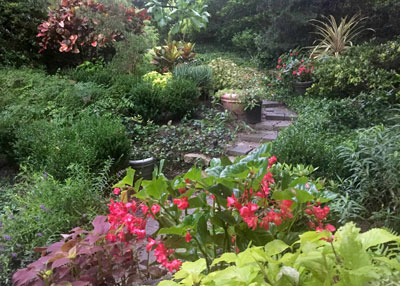Coping With a Soggy Garden
As I type this at 8 a.m. – just 10 hours before you’ll get it in your e-mail box tonight, we’ve just had another 1.6 inches of rain early this morning. At some point, almost every spot in Texas, even arid West Texas, has to face a time of what can be for the short term, excessive rains.
I decided we need to visit about how Texans should cope with the wet times. They may not come often, but it’s good to be ready when they do come. So here are my random thoughts. Hope they’re useful.

Photo: There was barely enough light to snap this 8 a.m. photo following a pounding rainstorm this morning. The Sperry gardens have received right at 10 inches of rain in the past 10 or 12 days. We are soggy!
Being prepared for the wet times…
For big parts of the eastern half of Texas the summer 2017 has been unusually wet. No matter where you live, you’re likely to encounter a week or two of really wet weather at one point or another. Here are ways to help your landscape survive them.
• Plant in raised beds so that incident rainfall will run away quickly. It’s easy to add water when you need it. It’s much more difficult to remove excessive water from an area. I mix in generous amounts of organic matter and 1 inch of expanded shale (or I buy a landscape mix that fits that description), and I build up my flower and vegetable gardens by 4 or 5 inches.
• Beware of grade changes such as berms that might redirect the flow of water in heavy rainstorms. A friend of mine built a long and extended berm (small mound) and covered it successfully with Asian jasmine groundcover. It worked wonderfully for several years until a 5-inch rain came in less than three hours and water backed up into his patio door. He had a major landscape remodeling project that had to be done right away.
• Surface drains can easily be installed in beds and turf areas. They use 4-inch PVC pipe and plastic grates. You find the low spot, and then all you need is a lower spot not too far away to which you can run the pipe and let the runoff exit your property. You only need 1/4- to 1/2-inch of fall per 10 feet to ensure the water will drain from the pipes.
• French drains can be installed using perforated 4-inch PVC pipes laid 10 or 12 inches below grade and taken to an exit point at a low spot on the property. I’ll let you do the research on how to install the system. It will require attention to detail. If you’re unsure of how to do the work or unable to do so, there are drainage specialists and landscape contractors who can help you.
• Know your plants’ tolerances of waterlogged soils. Many plants native to arid West Texas, for example, when planted in the eastern half of the state, struggle with even normal amounts of rainfall. (That’s probably why many of them don’t grow natively farther to the east.) Those plants will need to be “planted high,” that is, planted an inch or two higher than the surrounding terrain. Plant them atop short mounds, again so that incident rainfall will be shed away from their roots.
• Be sure your sprinkler system has some provision for shutting itself off when the soils are already filled with rainfall. We Texans never know when the next drought will come. It could be as soon as the last deluge stops. Conserve every possible drop of water, either by installation of a “Smart” controller or by leaving your system in the “Manual” mode so that you can determine when you should run it.
